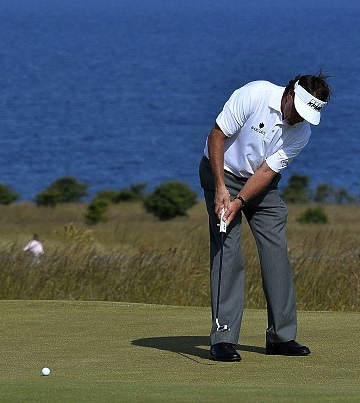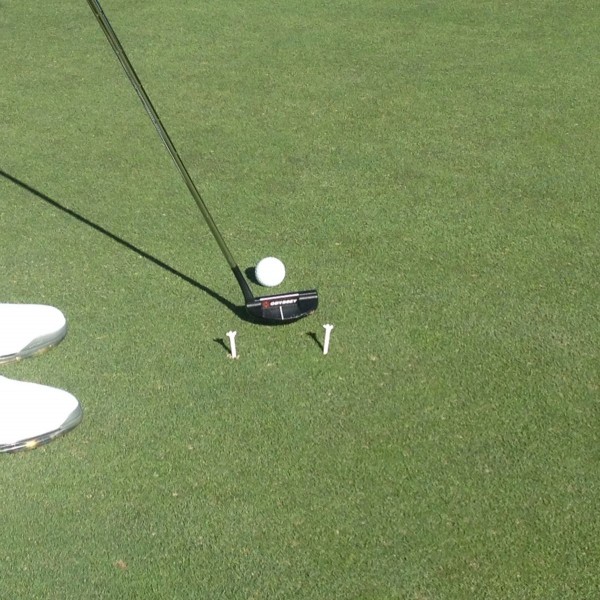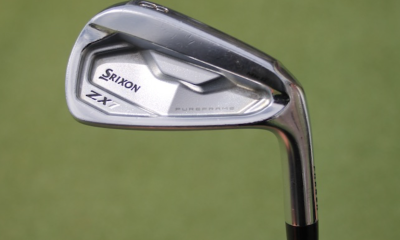Instruction
Putting: The Recoil, “the IF” and the finish

“How did I make a 12 on a par five hole?” Arnold Palmer said. “It’s simple. I missed a four-foot putt for an 11.”
There is an epidemic in the amateur golf world in regard to putting that I call “the recoil.” I see it all the time; it is when a golfer strikes a putt and immediately pulls their putter back toward the impact area. This usually takes place because of two reasons.
- A golfer is concerned about hitting the ball too hard.
- He or she is more concerned with making the putt than the proper putting stroke.
What a lot of golfers don’t realize, however, is that to have consistent putting results, they must have a consistent putting stroke.
A few things happen when golfers recoil their putter. First, the amount of energy they transfer into the ball can be very inconsistent. That’s because when golfers don’t follow through, their stroke can decelerate before they strike the ball.
The deceleration of the putter head causes another problem. Good putters have a natural acceleration of the putter head through impact, which keeps the putter face parallel to their path. When they finish their stroke, the putter head stays on its path, with the face pointing just left of the target. When golfers decelerate, however, their putter face can point anywhere, both at impact and at the finish position. All of this goes back to the emotions involved with golf, and the fear golfers have of running up their scores with too many putts.
Let’s imagine that you are playing a par 4 and reach the green in two shots. Most amateurs are pretty happy to make it to the green in regulation. But they’re not thinking birdie. Instead, they’re thinking, “don’t make a five.” They look at the putt and think, “IF I can get close enough, I can tap it in and get my par.”
When golfers think in terms of “if” when putting, they are setting themselves up for poor results. Given that same situation, tour players are thinking about making their birdie putt. They’re not worried about the next putt. In fact, they’re not even thinking about the possibility of missing the first putt.
You’ve probably noticed that when tour players hits a putt, they hold their finish confident the ball is going in the hole. Take Tiger Woods ,for example. He almost always holds his finish until the ball either goes in or passes the hole. Tiger doesn’t stand over a 20 footer thinking, “If I make this putt, I make birdie.” Instead, he stands over the putt and thinks, “I am going to make it, period.” To be a mentally tough player, you can’t consider the possibility of missing.
The next time you are standing over a putt, try to think only about the task at hand – your current putt and only your current putt. You should develop a good pre-shot routine, which will help you be confident that you will succeed. At the same time, be sure to finish your stroke and remove the recoil. I am not saying that if you do that the ball will go in the hole every time, because of course it won’t. Even tour players miss half their putts from six feet. But thinking positive and following through will certainly increase your chances. Focus on these simple adjustments while putting and you will be sure take some strokes off your game on the green.
Bonus drill: The next time you practice your putting stroke, use this simple and effective drill to stabilize your stroke. Grab two tees and your putter. Place your putter on the ground aiming at a hole. Then place a tee about one-eighth of an inch from the heel and the toe of the putter as in the photo below.
Take a couple practice strokes between the two tees making sure you don’t hit either one. Once you have some confidence in that you won’t hit either tee, go ahead and put a ball between them and try to make some short putts.
If you hit the tee off the toe of your putter, you likely have a “push stroke,” which means the putter face is too open at impact and you’ll tend to miss putts to the right of your target. If you hit the tee at the heel of your putter, you probably have a “pull stroke,” which means the putter face will be closed at impact and you will tend to miss putts to the left of the target.
In either case, the more you practice, the more consistent your stroke will become. A consistent, accelerating stroke means more made putts!
- LIKE4
- LEGIT1
- WOW0
- LOL0
- IDHT0
- FLOP0
- OB0
- SHANK0
Instruction
Clement: Laid-off or perfect fade? Across-the-line or perfect draw?

Some call the image on the left laid off, but if you are hitting a fade, this could be a perfect backswing for it! Same for across the line for a draw! Stop racking your brain with perceived mistakes and simply match backswing to shot shape!
- LIKE0
- LEGIT0
- WOW0
- LOL0
- IDHT0
- FLOP0
- OB0
- SHANK1
Instruction
The Wedge Guy: The easiest-to-learn golf basic

My golf learning began with this simple fact – if you don’t have a fundamentally sound hold on the golf club, it is practically impossible for your body to execute a fundamentally sound golf swing. I’m still a big believer that the golf swing is much easier to execute if you begin with the proper hold on the club.
As you might imagine, I come into contact with hundreds of golfers of all skill levels. And it is very rare to see a good player with a bad hold on the golf club. There are some exceptions, for sure, but they are very few and very far between, and they typically have beat so many balls with their poor grip that they’ve found a way to work around it.
The reality of biophysics is that the body moves only in certain ways – and the particulars of the way you hold the golf club can totally prevent a sound swing motion that allows the club to release properly through the impact zone. The wonderful thing is that anyone can learn how to put a fundamentally sound hold on the golf club, and you can practice it anywhere your hands are not otherwise engaged, like watching TV or just sitting and relaxing.
Whether you prefer an overlap, interlock or full-finger (not baseball!) grip on the club, the same fundamentals apply. Here are the major grip faults I see most often, in the order of the frequency:
Mis-aligned hands
By this I mean that the palms of the two hands are not parallel to each other. Too many golfers have a weak left hand and strong right, or vice versa. The easiest way to learn how to hold the club with your palms aligned properly is to grip a plain wooden ruler or yardstick. It forces the hands to align properly and shows you how that feels. If you grip and re-grip a yardstick several times, then grip a club, you’ll see that the learning curve is almost immediate.
The position of the grip in the upper/left hand
I also observe many golfers who have the butt of the grip too far into the heel pad of the upper hand (the left hand for right-handed players). It’s amazing how much easier it is to release the club through the ball if even 1/4-1/2″ of the butt is beyond the left heel pad. Try this yourself to see what I mean. Swing the club freely with just your left hand and notice the difference in its release from when you hold it at the end of the grip, versus gripping down even a half inch.
To help you really understand how this works, go to the range and hit shots with your five-iron gripped down a full inch to make the club the same length as your seven-iron. You will probably see an amazing shot shape difference, and likely not see as much distance loss as you would expect.
Too much lower (right) hand on the club
It seems like almost all golfers of 8-10 handicap or higher have the club too far into the palm of the lower hand, because that feels “good” if you are trying to control the path of the clubhead to the ball. But the golf swing is not an effort to hit at the ball – it is a swing of the club. The proper hold on the club has the grip underneath the pad at the base of the fingers. This will likely feel “weak” to you — like you cannot control the club like that. EXACTLY. You should not be trying to control the club with your lower/master hand.
Gripping too tightly
Nearly all golfers hold the club too tightly, which tenses up the forearms and prevents a proper release of the club through impact. In order for the club to move back and through properly, you must feel that the club is controlled by the last three fingers of the upper hand, and the middle two fingers of the lower hand. If you engage your thumbs and forefingers in “holding” the club, the result will almost always be a grip that is too tight. Try this for yourself. Hold the club in your upper hand only, and squeeze firmly with just the last three fingers, with the forefinger and thumb off the club entirely. You have good control, but your forearms are not tense. Then begin to squeeze down with your thumb and forefinger and observe the tensing of the entire forearm. This is the way we are made, so the key to preventing tenseness in the arms is to hold the club very lightly with the “pinchers” — the thumbs and forefingers.
So, those are what I believe are the four fundamentals of a good grip. Anyone can learn them in their home or office very quickly. There is no easier way to improve your ball striking consistency and add distance than giving more attention to the way you hold the golf club.
More from the Wedge Guy
- The Wedge Guy: Golf mastery begins with your wedge game
- The Wedge Guy: Why golf is 20 times harder than brain surgery
- The Wedge Guy: Musings on the golf ball rollback
- LIKE88
- LEGIT14
- WOW6
- LOL1
- IDHT0
- FLOP4
- OB1
- SHANK8
Instruction
Clement: Stop ripping off your swing with this drill!

Not the dreaded headcover under the armpit drill! As if your body is defective and can’t function by itself! Have you seen how incredible the human machine is with all the incredible feats of agility all kinds of athletes are accomplishing? You think your body is so defective (the good Lord is laughing his head off at you) that it needs a headcover tucked under the armpit so you can swing like T-Rex?
- LIKE0
- LEGIT3
- WOW2
- LOL0
- IDHT0
- FLOP0
- OB0
- SHANK2
-

 19th Hole2 weeks ago
19th Hole2 weeks agoJustin Thomas on the equipment choice of Scottie Scheffler that he thinks is ‘weird’
-

 19th Hole2 weeks ago
19th Hole2 weeks ago‘Absolutely crazy’ – Major champ lays into Patrick Cantlay over his decision on final hole of RBC Heritage
-

 19th Hole3 weeks ago
19th Hole3 weeks agoReport: LIV Golf identifies latest star name they hope to sign to breakaway tour
-

 19th Hole3 weeks ago
19th Hole3 weeks agoBrandel Chamblee has ‘no doubt’ who started the McIlroy/LIV rumor and why
-

 19th Hole1 week ago
19th Hole1 week agoLET pro gives detailed financial breakdown of first week on tour…and the net result may shock you
-

 Equipment3 weeks ago
Equipment3 weeks agoJason Day on his recent switch into Srixon ZX5 and ZX7 Mk II irons
-

 19th Hole5 days ago
19th Hole5 days agoGary Player claims this is what ‘completely ruined’ Tiger Woods’ career
-

 Whats in the Bag1 week ago
Whats in the Bag1 week agoTeam McIlowry (Rory McIlroy, Shane Lowry) winning WITBs: 2024 Zurich Classic




























Pingback: Putting: The Recoil, "the IF" and the finish - Golf Slot Machine
Chris
Oct 26, 2013 at 12:42 pm
I think the main emphasis of this article is PRACTICE, and CONFIDENCE in your stroke. I totally agree with him that the “might make it” mentality leads to little or no success with the putter. Pop stroke works for some but you know sneds has had tons of practice with it.
Pingback: Putting: The Recoil, “the IF” and the finish
John
Oct 24, 2013 at 10:31 pm
This is hogwash, and where the heck is this epidemic? Snedeker and Nicklaus both use a pop stroke. I just saw on the golf channel some pro talking about how more amateurs should stop focusing on the follow through and think more about just hitting the putt. You guys are like the global warming scientists and hurt your own credibility by being unable to agree. It’s no wonder every hack out there is so screwed up.
AJ
Oct 24, 2013 at 9:23 am
We hear this kind of stuff all the time:
“Tour pro’s aren’t thinking of missing the putt, period”.
Absolute rubbish. You’re telling me that a pro with a slippery 15 foot downhill snaker on crusty greens isn’t thinking about nudging it down to the hole so he doesn’t bash it 10 feet by?
If tour pro’s weren’t concerned with missing putts and the resulting ‘come-backer’ then everything would be smashed straight at the hole. They know the stats as well as anybody – making a putt outside of 15 -20 feet is statistically incredibly unlikely and therefore they get the ball as close as possible (i.e. within 12 inches), hoping it drops in.
[email protected]
Oct 22, 2013 at 8:47 am
Found this part VERY interesting “If you hit the tee at the heel of your putter, you probably have a “pull stroke,” which means the putter face will be closed at impact”
I naturally hit everything right to left..and my missed puts are pulls. Maybe the face and not the path…hmmm
Lazza
Oct 21, 2013 at 3:26 pm
What about the likes of Brandt Snedeker with his ‘pop’ putting style?